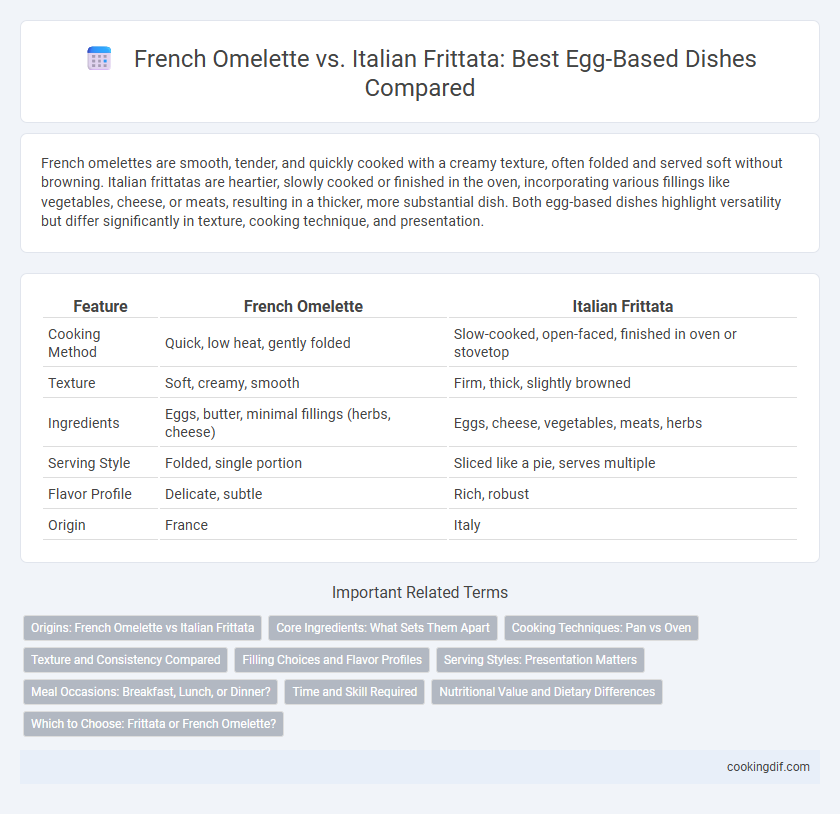French omelettes are smooth, tender, and quickly cooked with a creamy texture, often folded and served soft without browning. Italian frittatas are heartier, slowly cooked or finished in the oven, incorporating various fillings like vegetables, cheese, or meats, resulting in a thicker, more substantial dish. Both egg-based dishes highlight versatility but differ significantly in texture, cooking technique, and presentation.
Table of Comparison
| Feature | French Omelette | Italian Frittata |
|---|---|---|
| Cooking Method | Quick, low heat, gently folded | Slow-cooked, open-faced, finished in oven or stovetop |
| Texture | Soft, creamy, smooth | Firm, thick, slightly browned |
| Ingredients | Eggs, butter, minimal fillings (herbs, cheese) | Eggs, cheese, vegetables, meats, herbs |
| Serving Style | Folded, single portion | Sliced like a pie, serves multiple |
| Flavor Profile | Delicate, subtle | Rich, robust |
| Origin | France | Italy |
Origins: French Omelette vs Italian Frittata
French omelettes originated in France and are characterized by their soft, creamy texture achieved through gentle folding and low heat cooking, while Italian frittatas trace their roots to Italy and are known for their thicker, open-faced style cooked slowly and finished in the oven or under a broiler. The French omelette typically incorporates minimal fillings like herbs or cheese, emphasizing the delicate egg texture, whereas the Italian frittata includes a variety of vegetables, meats, and cheeses mixed into the egg base. Both dishes highlight regional culinary techniques reflecting their cultural origins but differ significantly in texture, cooking methods, and ingredient incorporation.
Core Ingredients: What Sets Them Apart
French omelettes feature a smooth, tender texture achieved by whisking eggs with minimal or no additional ingredients, often cooked quickly with butter and occasionally filled with herbs or cheese. In contrast, Italian frittatas incorporate a variety of core ingredients such as vegetables, meats, and cheeses directly into the beaten eggs before slow cooking, creating a thicker, more substantial dish. The distinction in ingredient integration and cooking method defines their unique textures and flavors.
Cooking Techniques: Pan vs Oven
French omelettes are typically cooked quickly over low heat in a pan, resulting in a tender, smooth texture with a slightly runny interior, whereas Italian frittatas are first started on the stovetop and finished in the oven to create a firm, evenly cooked dish with a golden top. The stovetop-to-oven technique of the frittata allows for thicker fillings and a more substantial, casserole-like consistency compared to the soft, delicate French omelette. Using the oven in frittata preparation ensures thorough cooking and a browned, crisp exterior that distinguishes it from the soft, folded omelette cooked solely on the pan.
Texture and Consistency Compared
French omelettes are characterized by their smooth, soft, and tender texture, achieved through gentle folding and brief cooking, resulting in a creamy interior with a slightly runny center. In contrast, Italian frittatas have a firm and dense consistency, cooked slowly through to a fully set interior, often incorporating fillings mixed uniformly throughout. The difference in cooking techniques leads to the French omelette's delicate, pliable texture, while the frittata offers a more substantial, sliceable quality.
Filling Choices and Flavor Profiles
French omelettes feature a delicate, smooth texture with minimal fillings such as fresh herbs, cheese, or mild vegetables to maintain a light flavor. Italian frittatas are heartier with diverse fillings like potatoes, meats, cheeses, and robust vegetables, creating bold and layered taste profiles. The French emphasis on subtlety contrasts with the Italian focus on rich, complex combinations in egg-based dishes.
Serving Styles: Presentation Matters
French omelettes are traditionally served folded into a smooth, creamy roll, showcasing a delicate and refined presentation that emphasizes simplicity and texture. In contrast, Italian frittatas are typically sliced like a pie, with a more rustic and hearty appearance, often accompanied by vegetables or cheese that highlight a rich, layered flavor profile. Presentation styles reflect cultural preferences, with the French focusing on elegance and the Italians on abundance and variety.
Meal Occasions: Breakfast, Lunch, or Dinner?
French omelettes, typically soft and creamy, are ideal for breakfast due to their light texture and quick preparation, offering a delicate start to the day. Italian frittatas, denser and packed with vegetables or meats, serve well for lunch or dinner as a hearty, protein-rich option suitable for more substantial meals. Both dishes utilize eggs but cater to different meal occasions through their preparation styles and ingredient inclusivity.
Time and Skill Required
French omelettes cook quickly, typically within 2-3 minutes, and demand precise technique to achieve their smooth, tender texture and uniformly light color. Italian frittatas take longer, usually 10-15 minutes, and require less delicate flipping skills but careful attention to evenly cook the thicker, more substantial egg mixture. Both dishes showcase different levels of time investment and culinary skill, with French omelettes emphasizing finesse and speed, while frittatas prioritize patience and even cooking.
Nutritional Value and Dietary Differences
French omelettes typically have a lighter texture and are cooked quickly, resulting in lower fat content due to minimal use of oil or butter, making them a lower-calorie option compared to Italian frittatas. Italian frittatas often include a variety of vegetables, cheeses, and meats mixed into the eggs, boosting their protein, fiber, and micronutrient content, but also increasing calories and fat levels. Dietary preferences influence choice: French omelettes suit low-fat, low-calorie diets, while frittatas provide a more nutrient-dense, satisfying meal ideal for higher protein or ketogenic plans.
Which to Choose: Frittata or French Omelette?
French omelettes are smooth, tender, and cooked quickly over low heat to maintain a creamy interior, perfect for delicate, refined flavors. Italian frittatas are thicker, heartier, and cooked slowly with fillings like vegetables, cheese, or meats mixed in, providing a more substantial and versatile dish. Choose a French omelette for a classic, elegant egg dish and a frittata for a robust, satisfying meal suitable for breakfast, lunch, or dinner.
French omelette vs Italian frittata for egg-based dishes Infographic

 cookingdif.com
cookingdif.com